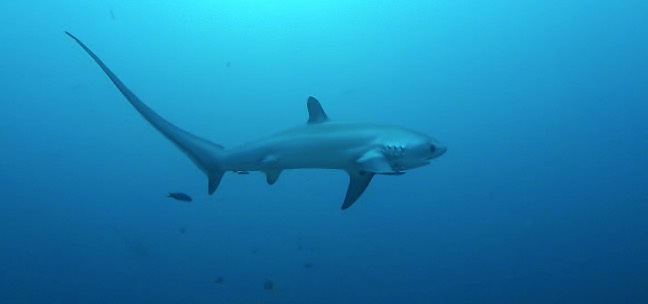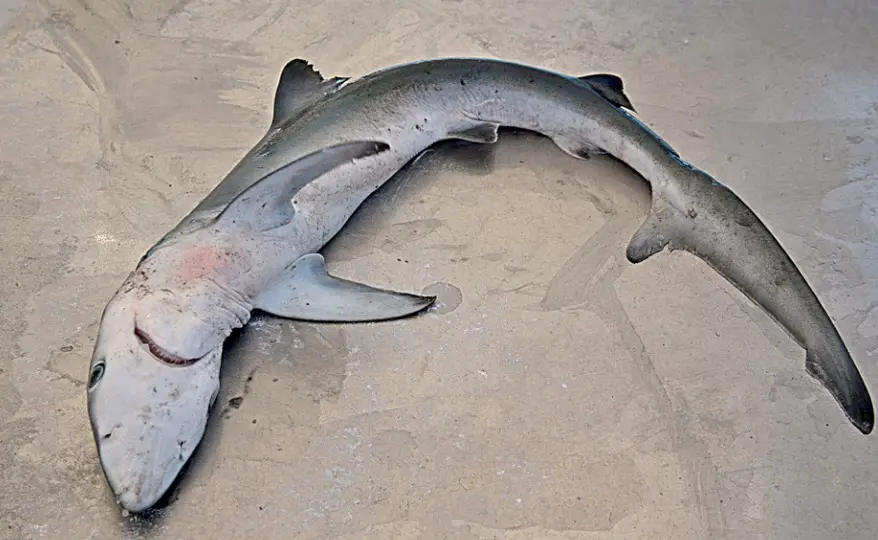Table of Contents
Thresher Shark: All You Need To Know
A Thresher shark is a pelagic predator which belongs to the kingdom of Animalia, phylum Chordata, and class Chondrichthyes. Its genus is Alopias and its species are A. vulpinus, A. pelagicus, and A. superciliosus. Its length is about 6.1 m and it weighs about 500 kg. It lives in the tropical and temperate oceans, with a lifespan up to 20+ years.

Thresher Shark Description
The thresher shark is a genus of three shark species found in all temperate and tropical oceans around the world. They have lengthy tails that can extend as far as the shark’s body. Their mouth and teeth are small, and their head is short and cone-shaped.
The Common Thresher (A. vulpinus) is the largest of the three species, measuring 20 feet (6.1 meters) in length and weighing over 1100 pounds. The Big Eye Thresher (A. superciliosus) grows to about 16 ft (4.9 m) and the Pelagic Thresher (A. pelagicus) reaches about 10 ft (3 ft) (3 ft). They are slender and have small dorsal fins and large pectoral fins with skin colour ranging from brown, blue, or purple-gray, depending on the species and water conditions, with lighter coloration on their dorsal side.

Thresher sharks are pelagic, which means they move freely in the water column rather than dwelling on the seafloor. They are mostly solitary hunters, but they do occasionally hunt in small groups of two or three people. Thresher sharks shock their food, usually schooling fish, with their long tails before spinning around to devour the disoriented prey.
They may follow the schools into shallow inshore areas, but they prefer to stay in deeper water. Squid and cuttlefish are among the mollusks eaten by threshers. They will occasionally look for crabs on the seabed or even seabirds on the surface. Larger shark species, as well as orcas, are their main predators. In the United States and South Africa, thresher sharks are coveted game fish, and in Baja California, Mexico, they are the subject of a sport fishery.
They are also caught up in the shark meat and fin trade. Because of overfishing and their sluggish growth rate, thresher sharks have been classified as vulnerable to extinction by the IUCN since 2007. The thresher shark does not have a specific breeding season.
Fertilization and embryonic development occur internally in sharks, as they do in many other animals. Females often have a small litter of 2-4 big puppies that may grow up to 59 in (150 cm) and mature slowly, becoming fertile between the ages of 7 and 14 years. Thresher sharks can live up to 20 years.
Do Thresher Shark Pose a Threat?
Thresher sharks are members of the Lamniformes order, which also contains the Great White shark. Lamniformes is derived from the Greek word Lamna, which means “fish of prey.” However, because of their small size and jaws, they are not a threat to people. Because they don’t eat huge prey of any sort, they’re less likely to confuse humans with their natural food, as is the case in most shark attacks. There has never been a record of a Thresher shark attacking a person.
Fun Facts About Thresher Shark
Due to their old ancestry and extensive fossil records, thresher sharks share many features with other shark species, making them excellent animals to study many biological concepts.
How Sharks Hide in the Dark?
Countershading, also known as Thayer’s Law, is a kind of crypsis or camouflaging seen across the animal kingdom in which an animal’s upper side is darker in colour than its bottom. It is an evolutionary adaption that may be seen in predatory and prey species, including mammals, reptiles, birds, fish, and insects.
When light falls from above on a three-dimensional object, the upper side appears lighter than the underside, where some shadows may still obstruct light. This makes it simpler to spot the item. Being noticed isn’t necessarily a positive thing in nature.
It might make it more difficult for an animal to surprise its prey. It can also make it more likely for predators to see it. This facilitated the evolution of countershading, which mitigates this occurrence across the animal kingdom. Despite the fact that their ventral colour varies, all Thresher sharks have a lighter dorsal coloration.
Imagine looking up at the animal from below, with the sun shining brightly in the background. You might also be staring down on the shark from above, with the dark ocean depths as a backdrop. It’s easy to understand how the brighter bottom and darker top side of Thresher sharks would make them more difficult to notice by both predators and prey in these circumstances.
Are Thresher Sharks Warm-blooded or Cold-blooded?
Endotherms are animals that can retain part of their internal heat to keep their body temperature at a biologically optimal level. Rather than depending only on ambient heat, this is usually accomplished by preserving part of the heat created by an organism’s internal organs. These creatures are frequently referred to as “warm-blooded.”
At least two Thresher shark species have a modified circulatory system that allows them to store metabolic heat. All mammals and birds, as well as tuna and billfish, have similar adaptations. Humans and other creatures are familiar with the phenomenon of shivering, which involves the redirection of blood to regions that create heat.
The animals can work more efficiently by reducing the amount of heat they dissipate into the environment, allowing them to subsist on less food than would otherwise be required. This is an obvious evolutionary benefit.
Thresher Shark Citations
- Thresher sharks use tail-slaps as a hunting strategy. PLoS One . 2013 Jul 10;8(7):e67380.
- Spiral valve parasites of blue and common thresher sharks as indicators of shark feeding behaviour and ecology. J Fish Biol . 2020 Aug;97(2):354-361.
- The denticle surface of thresher shark tails: Three-dimensional structure and comparison to other pelagic species. J Morphol . 2020 Aug;281(8):938-955.







